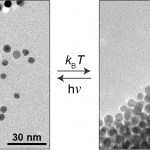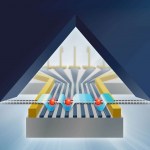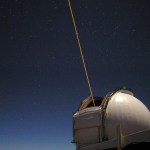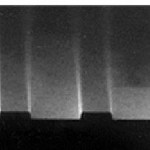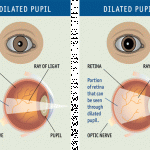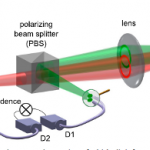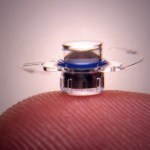Optics
One day in the future, we may be treating our ailments with microbiotic combinations designed specifically to correct imbalances in our personal microbiomes. We’ll bring our prescriptions on rewritable paper and pay using shimmery optical chips embedded in our cell phone cases or maybe our jewelry. Or we’ll be waiting in our doctor’s office for a simple test of our microbiogenome to see if a light-based nanoparticle delivery treatment is working, while watching iridescent optical displays that change as we move...
These future scenarios (and many more) are all imaginary, but…
Of the four new articles online on our website, three happen, purely by accident, to be on physics research. The three are very different, and yet each is an illustration of the ways that basic physics research changes our world – in small and large, practical and enlightening ways. And each is situated at a different intersection between the technological and the theoretical – a technological breakthrough that resulted from a successful attempt to provide proof for a theoretical construct, new inventions based on elementary physical principles of light, and a theory substantiated through a…
"But certainly the laser proved to be what I realized it was going to be. At that moment in my life I was too ignorant in business law to be able to do it right, and if I did it over again probably the same damn thing would happen." -Gordon Gould, inventor of the laser
You're used to the iconic image of an observatory's dome surrounded by a dark sky. From within, a telescope peers up at the heavens. And with a huge amount of light-gathering power that dwarfs a fully dilated human eye, we can use this tremendous tool to peek into the dark depths of the Universe.
Image credit: Fort Lewis…
Is anyone old enough to remember the ad in which two people walking down the street while snacking accidently bump into each other and discover peanut butter on a chocolate bar? Well, it turns out that when physics students run into each other on the street, the result is a quasicrystal with topological properties.
The students in question were members of two different labs in two different physics departments who were both out for a stroll on the same street in Tel Aviv – far from Rehovot and the Weizmann Institute. One was experimenting with a new kind of quasicrystalline optical system –…
"As far as we can discern, the sole purpose of human existence is to kindle a light in the darkness of mere being." -Carl Jung
During the daytime, light is plentiful and abundant, and the majority of our waking lives are optimized for that. But more and more of us are active late into the dark hours, when -- as Owen Pallett (formerly Final Fantasy) would tell us -- the last of
Your Light is Spent.
Unfortunately for us, our bodies are accustomed to certain types of light during the day, and expect a different type of night at light.
Image credit: TableTop Studio Ltd or LLC.
Because…
"I went into a clothing store, and the lady asked me what size I was. I said, 'Actual'. I'm not to scale." -Demitri Martin
When you look out at the Universe, what you can see is limited, at the most fundamental level, by the size of what you look with. This is why you can see dimmer objects at night -- when your pupils are dilated -- than you can when your pupils are constricted.
Image credit: National Institute of Health.
This same principle that applies to your eyes applies to telescopes as well. As telescopes have grown in size, so has our ability to see deeper into the Universe, as…
In which we do a little ResearchBlogging, taking a look at a slightly confusing paper putting a new twist on the double-slit experiment.
------------
I'm off to California this afternoon, spending the rest of the week at DAMOP in Pasadena (not presenting this year, just hanging out to see the coolest new stuff in Atomic, Molecular, and Optical Physics). I don't want to leave the blog with just a cute-kid video for the whole week, though, so here's some had-core physics: a new paper in the Proceedings of the National Academy of Sciences (freely available online), looking at a new sort of…
A while back, I explained how polarized sunglasses work, the short version of which is that light reflected off the ground in front of you tends to be polarized, and by blocking that light, they reduce the effects of glare. This is why fishermen wear polarized sunglasses (they make it easier to see through the surface of water) and why they're good for driving (they cut down on glare off the road ahead). I almost exclusively buy polarized sunglasses, because I like this feature.
But let's say you have a pair of polarized sunglasses that broke, because they were cheap to begin with (such as…
The second in the DAMOP research categories I talked about is "Extreme Lasers," a name I was somewhat hesitant to use, as every time I see "Extreme [noun]," I get a flash of Stephen Colbert doing air guitar. It is, however, the appropriate term, because these laser systems push the limits of what's possible both in terms of the pulse duration (attosecond pulses are common, with 1as = 0.000000000000000001 s) and the pulse intensity (1014 W/cm2 is a typical order-of-magnitude, and some systems get much higher than that).
One of the main tricks for generating these ultra-short pulses is to do…
That's the title of my slightly insane talk at the DAMOP (Division of Atomic, Molecular, and Optical Physics of the American Physical Society) conference a couple of weeks ago, summarizing current topics of interest in Atomic, Molecular, and Optical Physics. I'll re-embed the slides at the end of this post, for anyone who missed my earlier discussion.
I put a ton of work into that talk, and had a huge amount of material that I didn't have time to include. I'd hate for that to go to waste, so I'm going to repurpose it for blog content over the next week or so. It'll probably be about a half-…
It's been a long and brutally busy week here, so I really ought to just take a day off from blogging. But there's a new paper in Science on quantum physics that's just too good to pass up, so here's a ReasearchBlogging post to close out the week.
Aw, c'mon, dude, I'm tired. What's so cool about this paper that it can't wait until next week? Well, the title kind of says it all: they measured the average trajectories of single photons passing through a double-slit apparatus. By making lots of repeated weak measurements at different positions behind the slits, they could reconstruct the average…
Ernst Haeckel's Kunstformen der Natur (Artforms of Nature) was a landmark in biological illustration. Published in 1904, it was lavishly illustrated with 100 exquisitely detailed lithographic plates, including this one, showing nine different species of cubomedusae, or box jellyfish.
It has been known, since around the time that Haeckel's masterpiece was published, that box jellyfish have a unique visual system which is more sophisticated than that of other jellyfish species. They boast an impressive set of 24 eyes of four different types, which are clustered within bizarre sensory…
It's the last week of the (calendar) year, which means it's a good time to recap the previous twelve months worth of scientific news. Typically, publications like Physics World will publish a list of top ten physics stories of 2010, but we're all Web 2.0 these days, so it seems more appropriate to put this to a poll:
What is the top physics story of 2010?survey software
I've used the Physics World list as a starting point, because you have to start somewhere. I added a few options to cover the possibility that they left something out, and, of course, you know where the comments are.
This…
I've mentioned before that I'm answering the occasional question over at the Physics Stack Exchange site, a crowd-sourced physics Q&A. When I'm particularly pleased with a question and answer, I'll be promoting them over here like, well, now. Yesterday, somebody posted this question:
Consider a single photon (λ=532 nm) traveling through a plate of perfect glass with a refractive index n=1.5. We know that it does not change its direction or other characteristics in any particular way and propagating 1 cm through such glass is equivalent to 1.5 cm of vacuum. Apparently, the photon…
Over at Confused at a Higher Level, Melissa offers an alphabetical list of essential supplies for a condensed matter experimentalist at a small college. This is a fun idea for back-to-school time, so I'll steal it, and offer the following alphabetical list of essentials for Atomic, Molecular, and Optical physics at a small college, kind of a condensed version of the three part series I did a few weeks ago.
A is for Acousto-optic modulator This is a device that uses sound waves in a crystal to deflect light and shift its frequency. It's essential for rapid control of laser properties.
B is for…
Two papers in one post this time out. One of these was brought to my attention by Joerg Heber, the other I was reminded of when checking some information for last week's mathematical post on photons. They fit extremely well together though, and both relate to the photon correlation stuff I was talking about last week.
OK, what's the deal with these? These are two papers, one recent Optics Express paper from a week or so ago, the other a Nature article from a few years back. The Nature paper includes the graph you see at right, which is a really nice dataset demonstrating the Hanbury Brown and…
Following on yesterday's discussion of the vacuum hardware needed for cooling atoms, let's talk about the other main component of the apparatus: the optical system. The primary technique used for making cold atoms is laser cooling, and I'm sure it will come as no surprise that this requires lasers, and where there are lasers, there must also be optics.
There are lots of different types of lasers used for laser cooling experiments, but they all need to have certain properties: tunability, stability, and adequate power. Tunability is important because laser cooling requires light at exactly…
This week's big story in physics is this Science paper by a group out of Austria Canada (edited to fix my misreading of the author affiliations), on a triple-slit interference effect. This has drawn both the usual news stories and also some complaining about badly-worded news stories. So, what's the deal?
What did they do in this paper? The paper reports on an experiment in which they looked at the interference of light sent through a set of three small slits, and verified that the resulting pattern agrees with the predictions of the Born rule for quantum probabilities.
What does Matt Damon…
My grandmother suffered in her old age from macular degeneration, a common age-related eye disease that causes the center of your visual field (the macula) to gradually fritz out. As it affected her more and more, the font size in her emails ballooned to cartoonish sizes. She began walking with a cane, and needed a fancy electronic doo-dad to tell her when her cup of tea was full. By the end of her life, she was totally blind.
Watching my grandmother wink out from the world of seeing was tragic; the knowledge of macular degeneration's heredity terrifying. Relatives of those who have…
A press release from Harvard caught my eye last week, announcing results from Markus Greiner's group that were, according to the release, published in Science. The press release seems to have gotten the date wrong, though-- the article didn't appear in Science last week. It is, however, available on the arxiv, so you get the ResearchBlogging for the free version a few days before you can pay an exorbitant amount to read it in the journal.
The title of the paper is "Probing the Superfluid to Mott Insulator Transition at the Single Atom Level," which is kind of a lot of jargon. The key image is…
